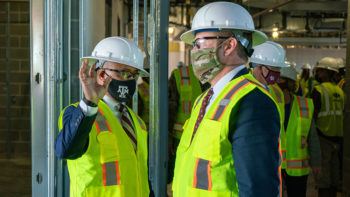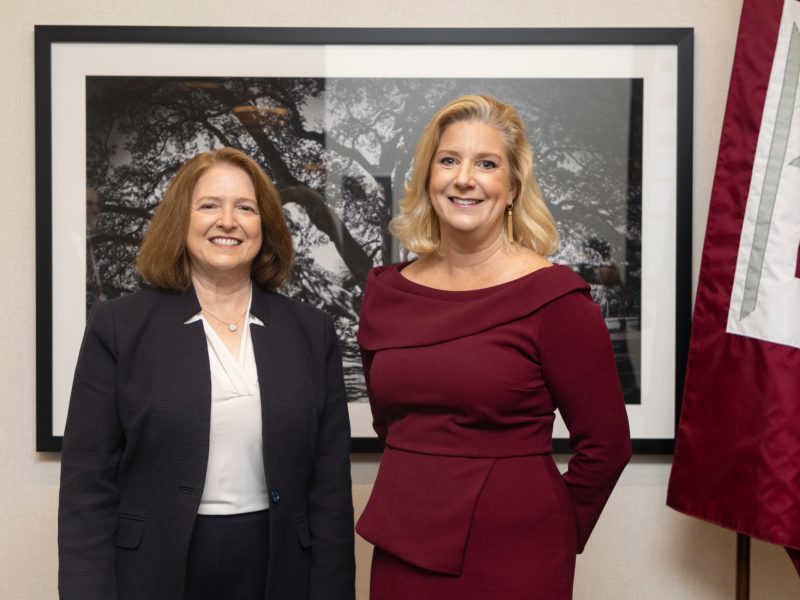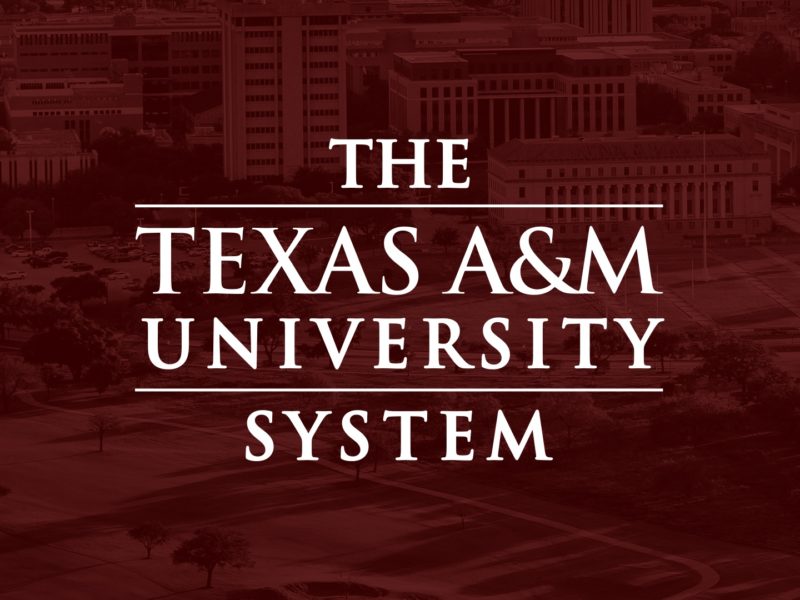U.S. Army Secretary Visits Bush Combat Development Complex

Army Secretary Ryan D. McCarthy visited the RELLIS Campus Wednesday to see progress on The Texas A&M University System’s new and unique contribution to military modernization.
McCarthy toured construction of the George H.W. Bush Combat Development Complex (BCDC), where leading U.S. researchers will work with warriors on high-tech solutions to real-world national security challenges.
The BCDC’s first strategic partner is the U.S. Army Futures Command (AFC), which has contracted with the Texas A&M System to research, experiment with and test prototypes for next-generation soldiering.
McCarthy started at the Research Integration Center, a three-story facility where engineers, scientists, soldiers and other stakeholders will collaborate on emerging technologies.
The secretary also saw the locations for two soon-to-be-built test ranges — one for hypersonic delivery systems, the other for battlefield communications and autonomous vehicles.
“This complex for collaboration in applied research is beyond any expectation I could have had,” McCarthy said. “There is a tremendous opportunity here with Texas A&M for the U.S. Army, obviously, but also for the defense industry.
“It’s a tremendous opportunity for industry to come, establish a footprint and vertically integrate research with manufacturing. The opportunity ceiling is very high.”
Designed in consultation with the military and the defense industry, the BCDC will fill critical gaps in the current modernization infrastructure. It will host experiments by researchers from Texas A&M University, other leading universities, the U.S. Army, other military branches, federal agencies, defense contractors and tech entrepreneurs.
“It’s no wonder that Secretary McCarthy marveled at the breadth of what we’re building,” said Col. Ross Guieb, BCDC executive director. “This will be a mini-research Pentagon — a high-tech hub for Army, industry and university-based experts to collaborate in one state-of-the-art location. Together we’ll develop next-generation defense capabilities to deter adversaries and convincingly win on any battlefield.”
Thanks to help from the Army and the State of Texas, the Texas A&M System is able to invest $200 million in the BCDC.
“We are proud to have Secretary McCarthy visit RELLIS as we prepare the campus to become America’s warfare innovation nexus,” said John Sharp, chancellor of the Texas A&M System. “We’re ready to meet the mission with an unmatched combination of facilities, researchers, expertise and devotion to service.”
Once completed, the BCDC will feature the largest enclosed hypersonic and directed energy testing range in the United States. It’s called BAM, which stands for Ballistic, Aero-optics and Materials. BAM will be one kilometer long and two meters in diameter, with instrumentation to test and evaluate high-energy lasers, hypersonic flight and the hypervelocity impact on various protective materials.
The Innovation Proving Ground (IPG) will host highly instrumented outdoor experiments on autonomous aerial, ground and subterranean vehicles as well as the smart communication systems, equipment and instruments needed in next-gen battlefield conditions.
“We are honored by Secretary McCarthy’s visit and pleased to show him how we are leveraging the state and federal investments with world-class researchers,” said Dr. M. Katherine Banks, vice chancellor for engineering and national laboratories of the Texas A&M System. “The BCDC reflects our enduring commitment to excellence in pursuit of national security.”
McCarthy also toured two other Texas A&M research laboratories for hypersonics and directed energy, and he met with students from the Corps of Cadets at Texas A&M.
Texas A&M was McCarthy’s first stop in Texas to check on Army innovation initiatives. Today he visits AFC’s headquarters in Austin.
About the Bush Combat Development Complex
The George H.W. Bush Combat Development Complex (BCDC), located on the 2,000-acre RELLIS Campus, is the result of a partnership between the U.S. Army Futures Command (AFC) and The Texas A&M University System, Texas A&M Engineering Experiment Station and the State of Texas. The $200 million complex will bring together researchers from U.S. universities, the military and the private sector for collaboration, demonstrations and high-tech testing of initiatives to help accelerate military innovation. The BCDC is funded with $50 million from the State Legislature, $65 million from AFC and $85 million from the Texas A&M System.
Media contacts:
- Laylan Copelin, vice chancellor of marketing and communications, 512-289-2782, lcopelin@tamus.edu
- Mike Reilly, marketing and communications, 402-679-0456, mreilly@tamus.edu





